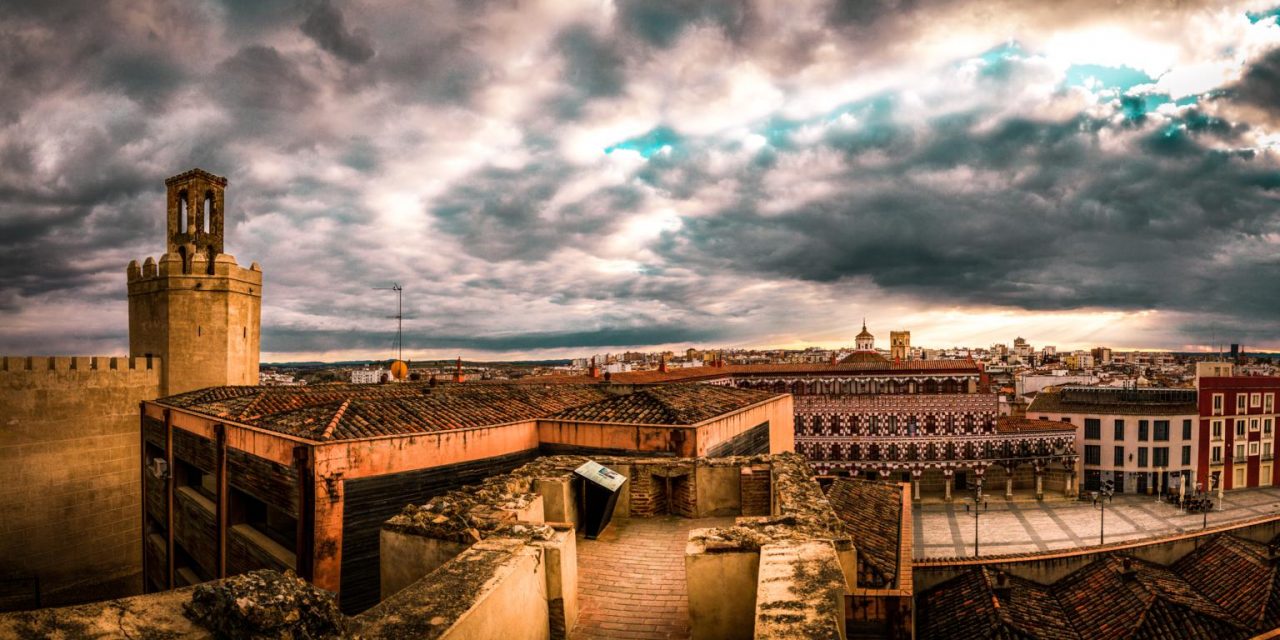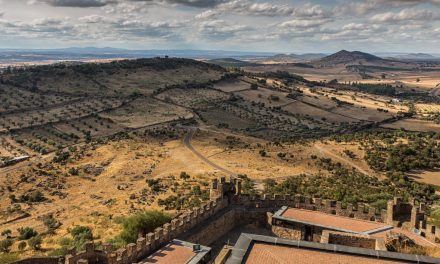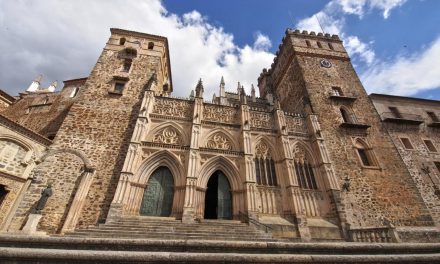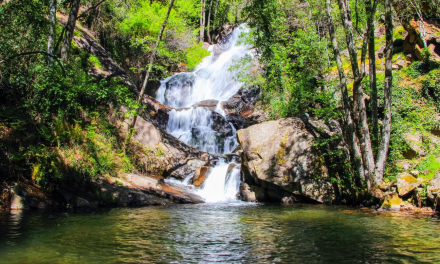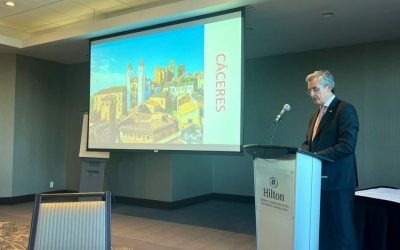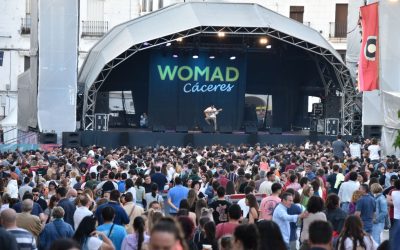De marcado carácter transfronterizo y mecida por las aguas del majestuoso río Guadiana, Badajoz se levanta en plena Raya Hispano-lusa coronada por su Torre de Espantaperros. Destino festivo, cultural y patrimonial, la ciudad más poblada de Extremadura nos obsequia con una rica experiencia turística y un gran legado histórico que se remonta al siglo IX, fecha en la que fue fundada por el rebelde Ibn Marwan.
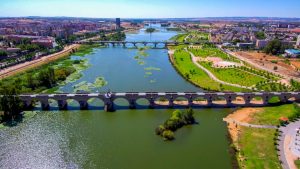
La cercanía de Portugal enriquece el día a día de Badajoz, joya enclavada en la sinuosa Raya que ofrece interesantes rutas por la ciudad que ayudan al viajero a entender los secretos de uno de los destinos imprescindibles al viajar por tierras extremeñas. La riqueza cultural de Badajoz ha permitido crear la Ruta de los Museos, que incluye el Arqueológico Provincial y el de Bellas Artes, ambos centenarios, además del famoso Museo Extremeño e Iberoamericano de Arte Contemporáneo (MEIAC), el del Carnaval y el Museo de la Catedral. El centro de visitantes del Fuerte de San Cristóbal, tras cientos de años de uso militar, es hoy en día el gran corazón museístico de la fortificación abaluartada, en torno a la cual se ha diseñado una sorprendente ruta que permite recorrer parte de los elementos de esta joya patrimonial que hoy constituye sin duda uno de los referentes turísticos más atractivos de Badajoz.
La muralla abaluartada se construyó a partir del siglo XVII para defender la ciudad ante un posible ataque de las tropas lusas. El devenir de la historia quiso que algunas de las partes de este monumento fuesen derribadas y la fortificación no impidió que la ciudad cayera a los ataques de los ejércitos franceses y británicos durante la Guerra de la Independencia.
La Ruta de las Puertas Históricas abre las puertas a estampas tan bellas como la de la emblemática Puerta de Palmas, la de la Trinidad o la Puerta de la Coracha o de la Traición. En este entorno resultan de obligada visita los edificios religiosos que se incluyen dentro de la Ruta de las Iglesias y los Conventos de Badajoz. En esta ciudad, las antiguas mezquitas se convirtieron en templos religiosos, y buen ejemplo de ello lo tenemos en Santa María del Castillo, que se levantó aprovechando la mezquita palaciega de la Alcazaba. De especial vistosidad son el retablo del altar mayor de la Catedral de Badajoz y el Monasterio de Santa Ana.
En Badajoz, los vestigios de casi 400 años de presencia árabe se funden en el Festival Almossassa, una cita de carácter internacional que congrega a miles de personas en la ciudad y que abre las puertas a las culturas cristianas, musulmana y judía. Para esta ocasión la Alcazaba pacense revive su pasado con un llamativo mercado medieval y con pintorescos espacios que diseñan un ambiente incomparable para una de las grandes celebraciones que cuentan con la declaración de Fiesta de Interés Turístico Regional.
Badajoz es una ciudad viva, cargada de ambiente, de magníficos restaurantes y tabernas que sirven la esencia de los sabores de la dehesa extremeña. Encinas y alcornoques crean un ecosistema único en el que se cría el cerdo ibérico y pastan reses que proporcionan unas carnes de magnífica calidad que, puestas en manos de los grandes cocineros de esta ciudad, se convierten en manjares de la tierra. Esta despensa natural única y la cercanía de Portugal hacen de Badajoz un destino para vivir experiencias gastronómicas únicas con materias primas de kilómetro 0 y que permiten sentir que el slow food es un lujo al alcance de todos.
Por este motivo se han creado varios recorridos gastronómicos, como la Ruta de la Buena Mesa, que incluye establecimientos de restauración de referencia en los que se fomentan los productos locales y la gastronomía más arraigada. Merece la pena adentrarse en la Ruta de las Tapas, de la que forman parte gastrobares, vinotecas y taperías que regalan una excelente cocina en miniatura. Además, se han diseñado itinerarios que recorren comercios, enotecas y espacios gastronómicos excepcionales y una ruta que da a conocer lo que es una verdadero arte en Badajoz, el desayuno.
La urbe moderna espera al viajero que llega a la ciudad para protagonizar el denominado turismo de compras en una ciudad que es todo un referente en la organización de ferias, certámenes, congresos y en la oferta de turismo de salud, y todo ello a un paso de Portugal.
Cuando llega el invierno, en Badajoz comienza a oler a fiesta con la llegada del Carnaval, una celebración internacionalmente conocida y considerada como una de las Fiestas de Interés Turístico Nacional más alegres y originales de nuestro país por obra y gracia de las murgas y los incombustibles ritmos de las comparsas. La perla del Guadiana, como también se conoce a la ciudad, también guarda un hueco para el fervor y el recogimiento, y lo demuestra cada Semana Santa con una celebración declarada Fiesta de Interés Turístico Nacional en la que destacan grandes procesiones como la del Sermón de las Siete Palabras o la de Jesús de la Espina.
Badajoz es una ciudad para visitar, pero sobre todo para vivir. El Festival Internacional de Jazz, la sucesión de eventos gastronómicos y su rico patrimonio arquitectónico -con verdaderas joyas como el Palacio de los Figueroa, la Plaza Alta o las Casas Mudejáres-, convierten a esta ciudad en un destino inolvidable para el viajero que llega a esta urbe con el deseo de explorar experiencias hasta ahora desconocidas.
Of marked cross-border character and bathed in the waters of the majestic Guadiana River, Badajoz stands right on the Spanish-Portuguese ‘Raya’ (border) and is crowned by its Espantaperros Tower. A leisure, culture and heritage destination, the most-populated city in Extremadura provides us with a rich tourism experience and a grand historical legacy which dates back to the ninth century, a date when it was founded by the rebel, Ibn Marwan.
Portugal’s proximity enriches the day-to-day of Badajoz, a jewel set on the sinuous ‘Raya’ (‘The Line’) which provides interesting routes through the city that aid the traveller in understanding the secrets of one the essential destinations when travelling around Extremaduran lands. Badajoz’s cultural wealth has made the creation of the museum route – la Ruta de los Museos – possible, and which includes the provincial Archaeological and the Fine Arts museums – both over a hundred years old, as well as the renowned MEIAC – Extremaduran and Latin American Contemporary Art Museum, the Carnaval and the Cathedral museums. The visitors centre at the San Cristóbal Fort, after hundreds of years of military use, is nowadays the great heart of the museum in the bastioned fortification, around which a surprising route has been designed which allows you to cover some of the sections of this heritage jewel, which without a doubt is currently one of the most appealing tourist attractions.
The bastioned wall was built from the seventeenth century onwards to defend the city against any possible attack by Portuguese troops. The developments of history meant that some parts of this monument were demolished and the fortification didn’t stop the city from falling to the attacks of the French and British armies during the War of Independence.
The Historic Gate Route (Ruta de las Puertas Históricas) opens the door to images as beautiful as that of the emblematic Puerta de Palmas, that of the Trinidad or the Puerta de la Concha or that of the Traición. In these surroundings it is essential to visit the religious buildings which are included in the Churches and Convents of Badajoz Route (Ruta de las Iglesias y los Conventos de Badajoz). In this city, the old mosques were turned into religious temples, and a good example of this is to be found at Santa María del Castillo, which was erected making use of the Alcazaba palatial mosque. Of especial note are the altarpiece of the high altar in Badajoz Cathedral and the Santa Ana Monastery.
In Badajoz, the vestiges of almost 400 years of Arabic presence come together in the Almossassa Festival, an international appointment that brings together thousands of people in the city and which reveals Christian, Muslim and Jewish cultures. For this occasion, the Badajoz Alcazaba relives its past with a striking medieval market and picturesque spaces that create an incomparable atmosphere for one of the big celebrations that can boast of receiving the declaration of ‘Fiesta de Interés Turístico Regional’ – a regional festivity of touristic interest.
Badajoz is a city which is alive, charged with atmosphere, full of magnificent restaurants and taverns which serve up the essence of the Extremaduran meadows. Holm oak and cork trees create a unique ecosystem where Iberian swine are bred and cows graze which provide meats of excellent quality that, in the hands of the excellent chefs in this city, become nature’s delicacies. This singular open-air larder and the proximity of Portugal make Badajoz a destination where you can live unique gastronomic experiences with all the ingredients produced locally and which makes you feel that slow food is a luxury everyone can afford.
It is for this reason that various gastronomic routes were created, such as the Ruta de la Buena Mesa (‘The Fine Foods Route’), which includes catering establishments of note where the use of local produce is fostered and the gastronomy more authentic. It is well-worth becoming familiar with the Ruta de las Tapas (The Snack Route’), which is composed of gastro-bars, wine bars and snack bars which provide excellent cuisine in snack-sized portions. What’s more, itineraries were designed that cover shops, wine cellars, exceptional gastronomic spots, and there is one route which shows what is a real art in Badajoz – breakfast.
The modern city is ready and waiting for the traveller who arrives in town to conduct a bit of so-called shopping tourism in a city which is a reference point with regard to organizing trade fairs, contests and conferences and its offering of health tourism – and all of it just a footstep away from Portugal.
When winter comes around, Badajoz begins to sweetly smell of festivities with the arrival of Carnaval, an internationally-renowned celebration, a ‘Fiesta de Interés Turístico Nacional’ (a local celebration deemed to be of national touristic interest), and considered to be one of the most cheerful and most original of our country thanks to the street bands and the unstoppable rhythms of the dance troupes. The pearl of the Guadiana, as the city is also known, also reserves a space for fervour and peace and quiet, and it shows it every Holy Week with the celebration declared ‘Fiesta de Interés Turístico Nacional’ during which stand out grand processions such as that of the ‘Sermón de las Siete Palabras’ or that of ‘Jesús de la Espina’.
Badajoz is a city to visit, but above all it’s a city to live. The International Jazz Festival, the succession of gastronomic events and its wealth of architectural heritage – with real jewels such as Figueroa Palace, the Plaza Alta or the Mudejár Houses – make this city an unforgettable destination for the traveller who arrives to this metropolis looking to explore new experiences never before known.


